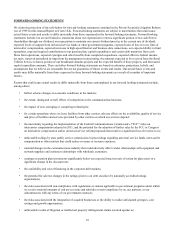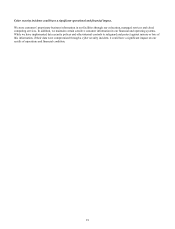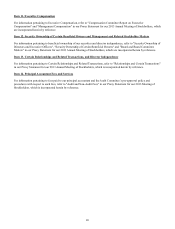Windstream 2012 Annual Report Download - page 78
Download and view the complete annual report
Please find page 78 of the 2012 Windstream annual report below. You can navigate through the pages in the report by either clicking on the pages listed below, or by using the keyword search tool below to find specific information within the annual report.16
we continue to reduce costs and lose voice lines. Pending regulatory proceedings could, depending on the outcome, materially
reduce our USF revenues.
Texas is continuing to review its USF funding mechanism, and any adverse developments could significantly affect our USF
revenues. Texas state USF revenues were $88.3 million in 2012.
We are required to make contributions to state and federal USF programs each year. Most state and federal regulations allow us
to recover these contributions by including a surcharge on our customers' bills. If state and/or federal regulations change, and
we become ineligible to receive support, such support is reduced, or we become unable to recover the amounts we contribute to
the state and federal USF programs from our customers, our results of operations and financial condition would be directly and
adversely affected.
Our operations require substantial capital expenditures, and if funds for capital expenditures are not available when
needed, this could affect our service to customers and our growth opportunities.
We require substantial capital to maintain our network, and our growth strategy will require significant capital investments for
network enhancements and build-out. During 2012, we incurred $1,101.2 million in capital expenditures, and we expect to
incur in excess of $800.0 million in capital expenditures in 2013 due to our significant investments in fiber-to-the-tower and
other initiatives. See "Liquidity and Capital Resources" for our expected capital expenditures in 2013.
We use a significant portion of our cash generated from operations to pay dividends to stockholders, which could limit our
ability to make the capital expenditures necessary to support our business needs and growth plans. We expect to be able to fund
required capital expenditures from cash generated from operations. However, other risk factors described in this section could
materially reduce cash available from operations or significantly increase our capital expenditure requirements. If this occurs,
funds for capital expenditures may not be available when needed, which could affect our service to customers and our growth
opportunities.
Unfavorable changes in financial markets could adversely affect our pension plan investments resulting in material funding
requirements to meet pension obligations.
Our pension plan invests in marketable securities, including marketable debt and equity securities denominated in foreign
currencies, which are exposed to changes in the financial markets. During 2012, the fair market value of these investments
increased from $948.9 million to $999.0 million due to return on assets held of $130.0 million, or 13.5 percent. These increases
were partially offset by routine benefit payments of $60.1 million and lump sum payments and administrative expenses of
$19.8 million. Returns generated on plan assets have historically funded a large portion of the benefits paid under our pension
plan.
We estimate that the long term rate of return on plan assets will be 7.0 percent, but returns below this estimate could
significantly increase our contribution requirements, which could adversely affect our cash flows from operations. Also,
historically low interest rates introduce lower discount rates, which directly increases the pension liability on our balance sheet
and exposes us to greater funding obligations in the future. During the fourth quarter of 2011, we changed our policy for
accounting for pension costs to immediately recognize gains or losses resulting from the return on plan assets and other true-
ups to other actuarial estimates. While this change does not affect cash flows, it will introduce the potential for volatility to our
earnings reported under accounting principles generally accepted in the United States ("U.S. GAAP"), especially if the return
on plan assets during the year differ significantly from the estimated rate of return.
Our substantial debt could adversely affect our cash flow and impair our ability to raise additional capital on favorable
terms.
As of December 31, 2012, we had approximately $8,996.5 million long-term debt outstanding, including current maturities. We
may also obtain additional long-term debt to meet future financing needs or to fund potential acquisitions, subject to certain
restrictions under our existing indebtedness, which would increase our total debt. Our substantial amount of debt could have
negative consequences to our business. For example, it could:
• Increase our vulnerability to general adverse economic and industry conditions;
























